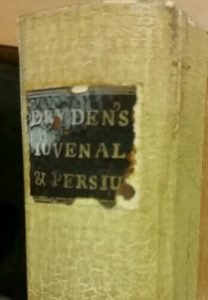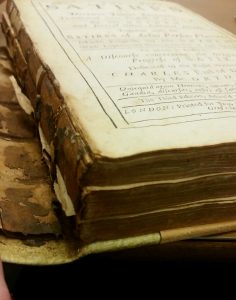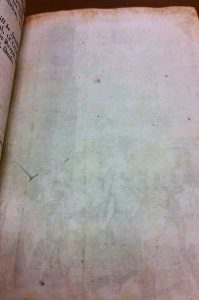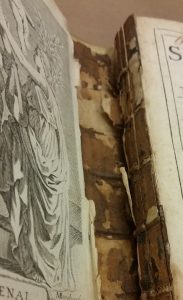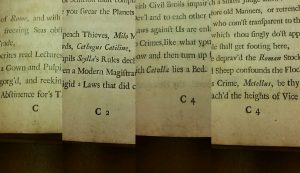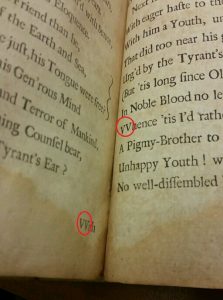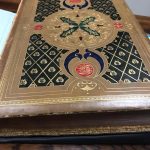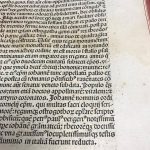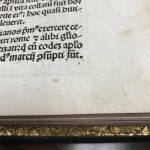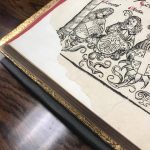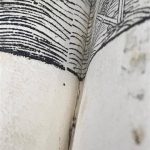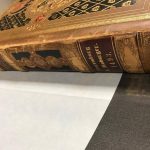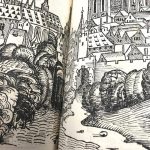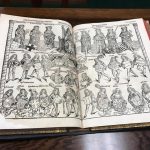It’s week two of our SLOB class, and another trip to the archives was called for. This time, we were on a mission; having covered a brief introduction to bibliography, everyone in the class was asked to identify certain traits of a book’s beginnings and figure out the format in which it was made. With that goal in mind, my partner Mary Haynes and I each grabbed a book and went to work.
I decided to use the oldest book in the Montevallo archives, which we identified last week: The Satires of Decimus Junius Juvenalis, 3rd ed. with sculptures. Published 1702.
Binding
This book was rebound by C.F. Rothweiler Bookbinding in Zion, Illinois, but the original binding can be seen attached to the new binding. Also, when rebound they cut out the title from the original binding and glued it onto the new spine.
Because they simply covered the old binding, there was no effect on the page margins. Although it is unfortunate that the original binding fell apart, because it happened I was able to clearly see the 5 stitch bindings. Another interesting thing about the binding was how it was falling apart. Upon further inspection is appeared to have split in three even sections, but there was evidence of smaller spitting happening as well. Mary Haynes and I came to the conclusion that this book was probably bound in smaller sections that were put into three bigger sections, and then finally bound together as a whole.
Paper
Right off the bat knew that the paper is laid, not wove. We can tell because of the visible chainlines, mostly horizontal but on pages with images the vertical wires can be seen as well. All of the pages are opened and are trimmed. I could not find a watermark despite looking for quite a while.
Signatures?
This is where, in my opinion, things got interesting. There were signatures at the bottom of the pages in groups of four. They were denoted by letters of the alphabet, starting with A, and continued until they had to start over with Aa. The interesting part about it was that the signatures were four on, four off. As you can see in the pictures, the pages followed an A1, A2, A3, A4 pattern but then followed by 4 pages without a signature.
Format
Based on the evidence we found (and a little origami on my part), I’ve come to the conclusion that this book was created using an octavo format. The biggest indicator of this was the signatures and their sets of four. Assuming they used them as a way to make sure the pages were in order when folding, it is safe to also assume that each new set of signatures means a new set of pages. If this is the case, that means there would be 8 leaves and 16 pages, hence, octavo.
Illustrations?
There were full page illustrations, generally with a black page on the opposing side. Because of that, I assume that the illustrations were printed separately and then bound together with the rest of the pages, but I did not see any glaring evidence of that so I may be wrong. Unfortunately, it slipped my mind to snap a picture of a whole illustration, but in this picture you can see part of one next to title page.
Extras
What caught my attention the most from examining the book was the way the typesetting worked. The first thing I noticed was actually a misprint in one of the signature series, as you can see in the pictures below.
After that I started looking for mistakes, but then stumbled upon something much more telling of the handmade nature of the book. Apparently when a page used too much of a single letter and the printer would run out, they would substitute other letters to make it work, usually with W’s and V’s as you can also see in the pictures.
Out of everything I found, I think my favorite was something that apparently was a product of the time this book was written. You see, Mary Haynes and I kept finding all of these works with seemingly random f’s where one would assume s’s would go. Having no idea what this could mean, we asked the archivist and discovered that back then, the f indicated a long s as opposed to a short s sound.
Overall, this visit was super cool and involved a lot of discovery. I had no idea that the structure of a book could be so fascinating, and I have a feeling I will never look at book bindings the same again. (Nor will my friends, because I’m a sharer when it comes to things like this.)

